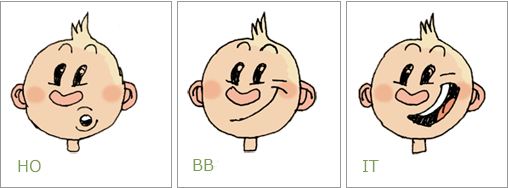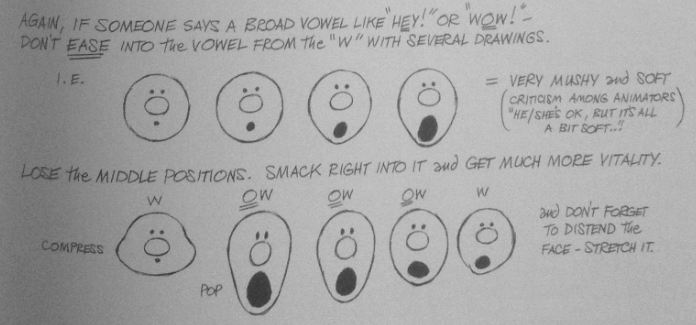Basic principles for good-looking lip sync
We are all different – some people enunciate dramatically (think Jim Carrey), while others hardly move their lips while speaking. Still, everybody opens their mouth for the vowels A, E, I, O and U – and close it for the consonants B, M, P, F, T, and Y. Everybody lifts the tongue up behind their front teeth for the consonant sounds N, D, L, TH, and T. Phrasing The realistic way to do lip sync is this:
Word shapes The feeling of the word HOBBIT breaks down, not into 6 letters, but into two or three word shapes:  Similarly, the word HELLO boils down to HE-O (E -> O), and FORTUNE breaks to FOR-UN (O -> U). Pop Animation is all about change: an overarching principle is to maximize change between frames. This keeps the viewer interested, and adds vitality. I'll quote a master: The Animator's Survival Kit, by award-winning director Richard Williams: 
(c) Richard Williams and Imogen Sutton, 2001 I love this example – it really shows the difference going from bland to exciting. Animate before the sound It doesn't get more important than the 'Sync' in Lip Sync. The eye accepts animation that leads the audio by one or two frames. But animation that trails the audio looks off-time. The rule is quite clear:
But by all means run a test, and discover if animating a frame in front of the audio looks good in your particular setting. It all depends on the speaker, and intent of the scene. Giving big vowels a frame extra to register with the eye can indeed improve the look of your animation, and it exists as a rule of thumb with animators, to run a frame or two in front of the audio. Anticipation Also, consider the anticipation before a big vowel: Anticipation is a crucial parts of good-looking animation. It is clearly seen in image above, Williams compresses the 'W' consonant face an extra bit in anticipation of popping into the big stretch of the 'O' vowel. SUMMARY
Notes
|
< Previous |
Next > |
| © SW 2025 | Contact |